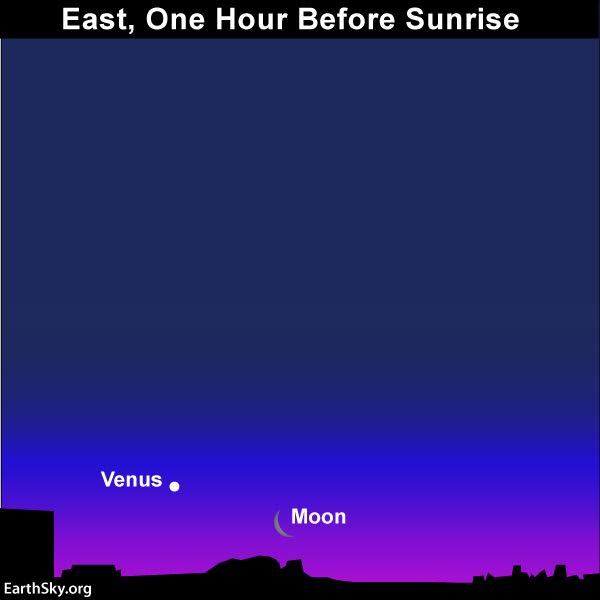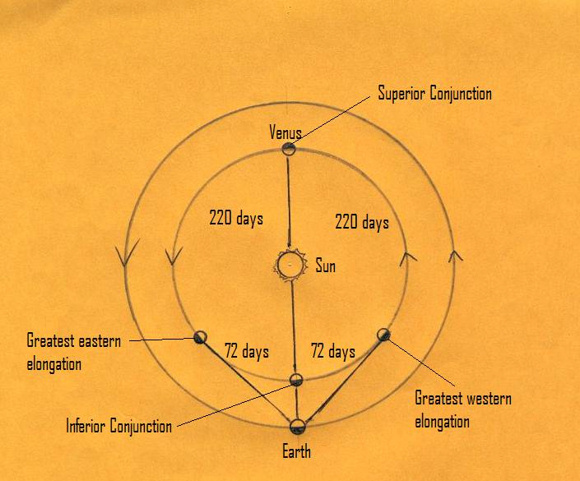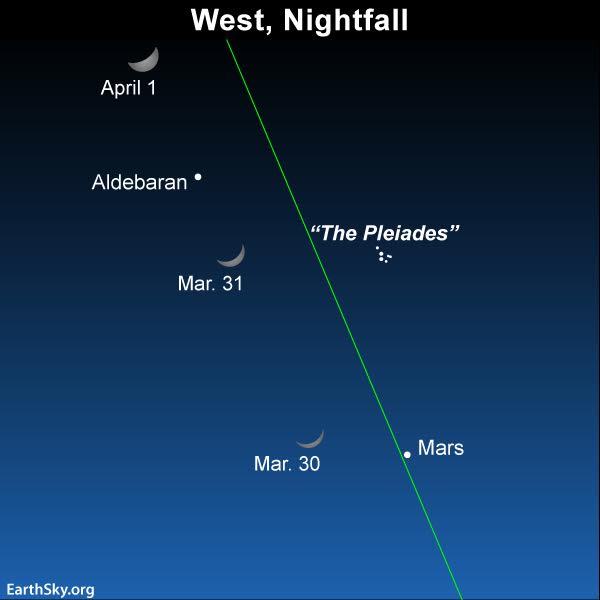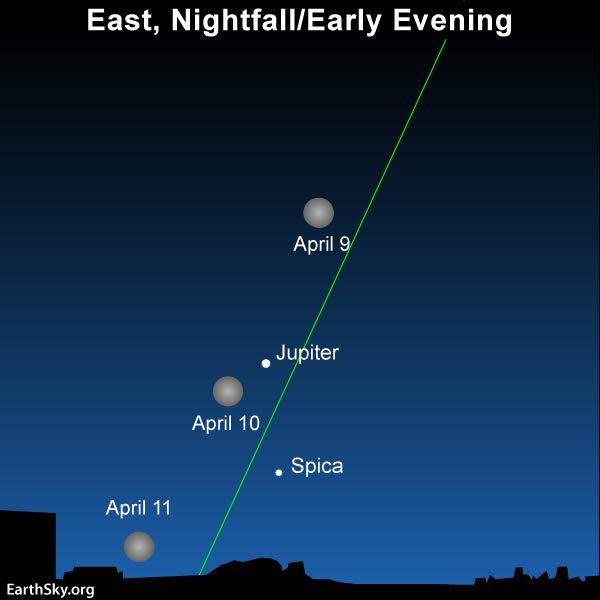April guide to the bright planets
By Bruce McClure and Deborah Byrd in Astronomy Essentials | April 1, 2017All 5 bright planets appear in the April night sky: Mercury and Mars at dusk, Jupiter all night long, Saturn from midnight until dawn and Venus before sunrise.

On April 1, 2017, the waxing moon is near the star Aldebaran in the constellation Taurus. Mars and Mercury are below the moon and Aldebaran – closer to the sunset point.
Our annual fund-raiser is here! Help EarthSky stay an independent voice.
All five bright planets appear in the April 2017 night sky. Mercury and Mars shine in the west at dusk/nightfall while the dazzling planet Jupiter beams in the southeast sky. Look for Mercury and Mars first because they’ll set in the west during the evening hours. Jupiter, on the other hand, will shine all night long, from sundown to sunup. The two morning planets are Saturn and Venus. As April 2017 opens, Saturn rises at late evening or around midnight. Venus, which transitioned over to the morning sky in late March 2017, now appears low in the east at morning dawn. Although Venus will remain in the morning sky for the rest of this year, Venus will actually beam at its brightest best as the morning “star” by the end of April! Follow the links below to learn more about the planets in April 2017.
Brilliant Venus low in east before sunrise
Mars, east of Mercury, until early evening
Saturn lights up morning sky
Bright Jupiter from dusk till dawn
Mercury in the evening sky
Like what EarthSky offers? Sign up for our free daily newsletter today!
Astronomy events, star parties, festivals, workshops
Visit a new EarthSky feature – Best Places to Stargaze – and add your fav.

Skywatcher, by Predrag Agatonovic.

For a few days, centered on April 23, 2017, watch for the beautiful pairing of the waning crescent moon with Venus, the sky’s brightest planet. Read more
Brilliant Venus low in the east before sunrise Until fairly recently, Venus had been an evening object, lighting up the western sky after sunset. Venus, in its faster and smaller orbit around the sun, passed in between the sun and Earth on March 25, 2017. At this juncture, at Venus’ March 25 inferior conjunction, Venus transitioned out of the evening sky and into the morning sky.
In short, when Venus was east of the Earth-sun line in the first several weeks of March 2017, we saw Venus as an evening “star” in the west after sunset. After Venus’ inferior conjunction on March 25, Venus then moved to the west of the Earth-sun line, placing Venus in the eastern morning sky before sunrise. Because Venus will be to the west of the Earth-sun line for the rest of the year, Venus will remain a morning star throughout 2017. The chart below helps to illustrate.

The Earth and Venus orbit the sun counterclockwise as seen to the north of the solar system plane. When Venus is to the east (left) of the Earth-sun line, we see Venus as an evening “star” in the west after sunset. After Venus reaches its inferior conjunction, Venus then moves to the west (right) of the Earth-sun line, appearing as a morning “star” in the east before sunrise.
Actually, since Venus passed 8o north of the sun on its March 25 inferior conjunction, it was possible to see Venus as both the evening and morning “star” for several days at northerly latitudes. That’s because, at northerly latitudes, far-northern Venus set after the sun and then came up before the sun as this inferior planet moved over to the morning sky. If you missed the double feature of Venus as both an evening and morning “star,” keep in mind that the double feature recurs in cycles of 8 years. It’ll happen again when Venus reaches its 5th inferior conjunction in 8 years on March 23, 2025 – and then its 10th inferior conjunction in 16 years on March 20, 2033.
Venus after sunset and before sunrise!
If you’re an early bird, you can count on Venus to be your morning companion for many months to come. This month, in April 2017, enjoy the picturesque coupling of the waning crescent moon and Venus in the eastern sky before sunrise on or near April 23, and witness Venus at its greatest illuminated extent on April 30, 2017.
From mid-northern latitudes (U.S. and Europe), Venus rises about one hour before the sun in early April and nearly two hours before sunrise by the month’s end.
At mid-southern latitudes (Australia and South Africa), Venus rises about about one hour before the sun in early April and 3 hours before sunup by the month’s end.
Click here for an almanac giving rising time of Venus in your sky.

Use the moon to find the planet Mars, the star Aldebaran and the Pleiades cluster as darkness falls on April 1. Read more.
Mars, east of Mercury, until early evening. After appearing as a fiery red light in our sky last May and June 2016, Mars is now a fading ember of its former self. Look for Mars rather low in the west as soon as darkness falls because it’ll follow the sun beneath the horizon by nightfall or early evening. Since Mars is edging closer to the sunset day by day, it’ll disappear in the twilight glare in a month or two.
Mars is not the only celestial object to sink into the twilight dusk in April. In fact, you can use Mars to spot the fading Pleiades star cluster, starting on or near April 17. The Zuni of New Mexico called the Pleiades the “Seed Stars” because the cluster’s disappearance from the evening sky signaled that the danger of frost had passed.
From mid-northern latitudes (U.S. and Europe), look for the red planet Mars to set in the west roughly an hour after nightfall in early April and around nightfall by the month’s end.
At mid-southern latitudes (Australia and South Africa), Mars sets at late dusk or nightfall all month long. Mars may be hard to see in the twilight glare from southerly latitudes and binoculars might be needed to spot it.
Let the waxing crescent moon help guide you to Mars on April 27 and 28. Don’t mistake the red star Aldebaran for the red planet Mars, this 1st-magnitude star shining twice as brilliantly as the red planet.

Let the waxing crescent moon help guide your eye to Mars on April 27 and 28. Read more.
Mars will linger in our sky for a few more months. Keep in mind, however, that Earth is traveling away from Mars as we speak – moving far ahead of this planet in the endless race around the sun – so Mars is dimming in our evening sky. Mars is in its long, lingering, relatively inconspicuous phase now. At tropical and northerly latitudes, it’ll be still visible in the west to the unaided eye, though not prominent.
Mars won’t make its transition from the evening to morning sky until July 27, 2017. Even so, Mars’ stature in the evening sky will continue to diminish to that of a rather faint “star,” and we expect few – if any – skywatchers to observe the conjunction of Mars and Mercury in the evening sky on June 28, 2017.
The conjunction of Mars and Venus in the morning sky on October 5, 2017, may well present the first good opportunity to spot Mars in the morning sky when it returns from being behind the sun on July 27, 2017.
Looking for a sky almanac? EarthSky recommends…

View larger | Mikhail Chubarets in the Ukraine made this chart. It shows the view of Mars through a telescope in 2016. We never see Mars as a disk like this with the eye alone. But you can see why Mars was bright to the eye in 2016, and is now fading.

Are you an early riser? Look for the moon, the star Antares and the planet Saturn in the predawn and dawn sky on April 15, 16 and 17. Read more.
Saturn lights up morning sky. Saturn swung behind the sun on December 10, 2016, transitioning from the evening to morning sky. In both the Northern and Southern Hemispheres, Saturn is easy to view in the morning sky throughout April 2017. From mid-northern latitudes, Saturn rises in the east around midnight local time (1 a.m. daylight-saving time) in early April, and by the month’s end, Saturn comes up somewhere around 10 to 11 p.m. local time (11 p.m. to midnight daylight-saving time).
At temperate latitudes in the Southern Hemisphere, Saturn rises about 10 p.m. local time in early April, and by the month’s end, Saturn rises around 8:30 p.m. local time.
But your best view of Saturn, from either the Northern or Southern Hemisphere, is during the dark hour before dawn. That’s when Saturn climbs highest up for the night. Click here to find out when astronomical twilight starts in your morning sky (remember to click on the astronomical twilight box).
Be sure to let the waning crescent moon guide you to Saturn (and the nearby star Antares) for several days, centered on or near April 16 or 17.
Saturn, the farthest world that you can easily view with the eye alone, appears golden in color. It shines with a steady light.
Binoculars don’t reveal Saturn’s gorgeous rings, by the way, although binoculars will enhance Saturn’s golden color. To see the rings, you need a small telescope. A telescope will also reveal one or more of Saturn’s many moons, most notably Titan.
Saturn’s rings are inclined at nearly 27o from edge-on, exhibiting their northern face. In October 2017, the rings will open most widely, displaying a maximum inclination of 27o.
As with so much in space (and on Earth), the appearance of Saturn’s rings from Earth is cyclical. In the year 2025, the rings will appear edge-on as seen from Earth. After that, we’ll begin to see the south side of Saturn’s rings, to increase to a maximum inclination of 27o by May 2032.
Click here for recommended almanacs. They can help you know when the planets rise, transit and set in your sky

Tom Wildoner over-exposed Saturn itself to capture this view of Saturn’s moons on June 25, 2016. Visit Tom at LeisurelyScientist.com.

Contrasting the size of Saturn and its rings with our planet Earth via Hubble Heritage Team.

As the moon travels in front of the constellation Virgo on April 9, 10 and 11, it bypasses the king planet Jupiter and Spica, Virgo’s brightest star. Read more.
Bright Jupiter from dusk till dawn. Jupiter reaches opposition on April 7 and comes closest to Earth for the year on April 8. Jupiter will not only shine at its brightest best for all of 2017 but it’ll beam all night long, from dusk till dawn.
Jupiter’s prominence in the nighttime sky will be hard to overlook in April 2017. Seek out the brightest starlike object at nightfall and that’ll probably be the king planet Jupiter! Look low in the southeast sky.
From mid-northern latitudes, like those in the U.S. and Europe, Jupiter rises at dusk or nightfall in early April. By the month’s end, Jupiter is seen above the horizon at dusk.
The same applies to tropical latitudes and mid-southern latitudes (Australia). Jupiter rises shortly after sunset in early April and shines above the horizon at dusk in late April.
Watch for a full-looking moon to join up with Jupiter for several days, centered on or near April 10, just a few days after Jupiter’s opposition date. Despite the moonlit glare, Jupiter should be able to withstand the onslaught of moonlight. See the above sky chart.
By the way, Jupiter shines in front of the constellation Virgo, near Virgo’s sole 1st-magnitude star, Spica. Jupiter serves a great reference for learning the constellations of the zodiac, because Jupiter stays in each constellation for roughly a year. So use Jupiter to become familiar with the star Spica and the constellation Virgo, starting now, and throughout 2017.

Look for the planet Jupiter to rise into your southeast sky after dark. If you are blessed with a dark sky, seek out the constellation Corvus near Jupiter and Spica, the brightest star in the constellation Virgo the Maiden.
If you have binoculars or a telescope, it’s fairly easy to see Jupiter’s four major moons, which look like pinpricks of light on or near the same plane. They are often called the Galilean moons to honor Galileo, who discovered these great Jovian moons in 1610. In their order from Jupiter, these moons are Io, Europa, Ganymede and Callisto.

Jupiter and its four major moons via Jan Sandberg
These moons circle Jupiter around the Jovian equator. In cycles of six years, we view Jupiter’s equator edge-on. So, in 2015, we got to view a number of mutual events involving Jupiter’s moons through a high-powered telescope. Click here or here or here for more details.
Although Jupiter’s axial tilt is only 3o out of perpendicular relative to the ecliptic (Earth’s orbital plane), Jupiter’s axis will tilt enough toward the sun and Earth so that the farthest of these four moons, Callisto, will NOT pass in front of Jupiter or behind Jupiter for a period of about three years, starting in late 2016. During this approximate 3-year period, Callisto will remain “perpetually” visible, alternately swinging “above” and “below” Jupiter.
Click here for a Jupiter’s moons almanac, courtesy of Sky & Telescope.

Wow! Wonderful shot of Mercury – over the Chilean Andes – January 31, 2017, from Yuri Beletsky Nightscapes.

For northerly laitudes, the planet Mercury is making its best evening appearance for the year. Look westward some 45 to 60 minutes after sunset. Read more.
Mercury in the evening sky. For the Northern Hemisphere, Mercury will put on a good showing in the western evening sky for several weeks, centered on April 1. Mercury should be in fine view when the waxing crescent moon pairs up with Mercury on March 29.
Mercury is tricky. If you look too soon, Mercury will still be obscured by the haze of evening twilight; if you look too late, it will have followed the sun beneath the horizon. Watch for Mercury low in the sky, and near the sunset point on the horizon, seeking for this hidden treasure around 45 to 75 minutes after sunset. Remember, binoculars are always helpful for any Mercury search. Good Luck!
For the Northern hemisphere, this particular apparition of Mercury in the evening sky will be the best of the year. From temperate latitudes in the Southern Hemisphere, it’ll be a poor evening showing of Mercury. But don’t despair if you live at southerly latitudes. You’ll have your turn, when a super apparition of Mercury takes place in your morning sky all during May of 2017.
Click here for recommended almanacs; they can give you Mercury’s setting time in your sky.
What do we mean by bright planet? By bright planet, we mean any solar system planet that is easily visible without an optical aid and that has been watched by our ancestors since time immemorial. In their outward order from the sun, the five bright planets are Mercury, Venus, Mars, Jupiter and Saturn. These planets actually do appear bright in our sky. They are typically as bright as – or brighter than – the brightest stars. Plus, these relatively nearby worlds tend to shine with a steadier light than the distant, twinkling stars. You can spot them, and come to know them as faithful friends, if you try.

This image is from February 8, 2016. It shows all 5 bright planets at once. Photo by our friend Eliot Herman in Tucson, Arizona.
Bottom line: In April 2017, three of the five bright planets appear in the evening sky: Mars, Jupiter and Mercury. Saturn and V enus are found the morning sky.
Easily locate stars and constellations with EarthSky’s planisphere.
Don’t miss anything. Subscribe to EarthSky News by email
Thanks to: http://earthsky.org






 Sat Mar 23, 2024 11:33 pm by globalturbo
Sat Mar 23, 2024 11:33 pm by globalturbo

